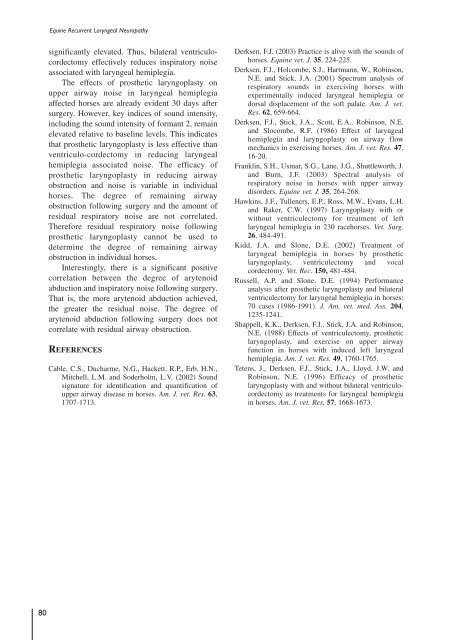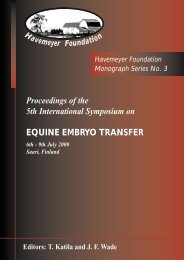Proceedings of a Workshop on - The Havemeyer Foundation
Proceedings of a Workshop on - The Havemeyer Foundation
Proceedings of a Workshop on - The Havemeyer Foundation
Create successful ePaper yourself
Turn your PDF publications into a flip-book with our unique Google optimized e-Paper software.
Equine Recurrent Laryngeal Neuropathy<br />
significantly elevated. Thus, bilateral ventriculocordectomy<br />
effectively reduces inspiratory noise<br />
associated with laryngeal hemiplegia.<br />
<strong>The</strong> effects <str<strong>on</strong>g>of</str<strong>on</strong>g> prosthetic laryngoplasty <strong>on</strong><br />
upper airway noise in laryngeal hemiplegia<br />
affected horses are already evident 30 days after<br />
surgery. However, key indices <str<strong>on</strong>g>of</str<strong>on</strong>g> sound intensity,<br />
including the sound intensity <str<strong>on</strong>g>of</str<strong>on</strong>g> formant 2, remain<br />
elevated relative to baseline levels. This indicates<br />
that prosthetic laryngoplasty is less effective than<br />
ventriculo-cordectomy in reducing laryngeal<br />
hemiplegia associated noise. <strong>The</strong> efficacy <str<strong>on</strong>g>of</str<strong>on</strong>g><br />
prosthetic laryngoplasty in reducing airway<br />
obstructi<strong>on</strong> and noise is variable in individual<br />
horses. <strong>The</strong> degree <str<strong>on</strong>g>of</str<strong>on</strong>g> remaining airway<br />
obstructi<strong>on</strong> following surgery and the amount <str<strong>on</strong>g>of</str<strong>on</strong>g><br />
residual respiratory noise are not correlated.<br />
<strong>The</strong>refore residual respiratory noise following<br />
prosthetic laryngoplasty cannot be used to<br />
determine the degree <str<strong>on</strong>g>of</str<strong>on</strong>g> remaining airway<br />
obstructi<strong>on</strong> in individual horses.<br />
Interestingly, there is a significant positive<br />
correlati<strong>on</strong> between the degree <str<strong>on</strong>g>of</str<strong>on</strong>g> arytenoid<br />
abducti<strong>on</strong> and inspiratory noise following surgery.<br />
That is, the more arytenoid abducti<strong>on</strong> achieved,<br />
the greater the residual noise. <strong>The</strong> degree <str<strong>on</strong>g>of</str<strong>on</strong>g><br />
arytenoid abducti<strong>on</strong> following surgery does not<br />
correlate with residual airway obstructi<strong>on</strong>.<br />
REFERENCES<br />
Cable, C.S., Ducharme, N.G., Hackett, R.P., Erb, H.N.,<br />
Mitchell, L.M. and Soderholm, L.V. (2002) Sound<br />
signature for identificati<strong>on</strong> and quantificati<strong>on</strong> <str<strong>on</strong>g>of</str<strong>on</strong>g><br />
upper airway disease in horses. Am. J. vet. Res. 63,<br />
1707-1713.<br />
Derksen, F.J. (2003) Practice is alive with the sounds <str<strong>on</strong>g>of</str<strong>on</strong>g><br />
horses. Equine vet. J. 35, 224-225.<br />
Derksen, F.J., Holcombe, S.J., Hartmann, W., Robins<strong>on</strong>,<br />
N.E. and Stick, J.A. (2001) Spectrum analysis <str<strong>on</strong>g>of</str<strong>on</strong>g><br />
respiratory sounds in exercising horses with<br />
experimentally induced laryngeal hemiplegia or<br />
dorsal displacement <str<strong>on</strong>g>of</str<strong>on</strong>g> the s<str<strong>on</strong>g>of</str<strong>on</strong>g>t palate. Am. J. vet.<br />
Res. 62, 659-664.<br />
Derksen, F.J., Stick, J.A., Scott, E.A., Robins<strong>on</strong>, N.E.<br />
and Slocombe, R.F. (1986) Effect <str<strong>on</strong>g>of</str<strong>on</strong>g> laryngeal<br />
hemiplegia and laryngoplasty <strong>on</strong> airway flow<br />
mechanics in exercising horses. Am. J. vet. Res. 47,<br />
16-20.<br />
Franklin, S.H., Usmar, S.G., Lane, J.G., Shuttleworth, J.<br />
and Burn, J.F. (2003) Spectral analysis <str<strong>on</strong>g>of</str<strong>on</strong>g><br />
respiratory noise in horses with upper airway<br />
disorders. Equine vet. J. 35, 264-268.<br />
Hawkins, J.F., Tulleners, E.P., Ross, M.W., Evans, L.H.<br />
and Raker, C.W. (1997) Laryngoplasty with or<br />
without ventriculectomy for treatment <str<strong>on</strong>g>of</str<strong>on</strong>g> left<br />
laryngeal hemiplegia in 230 racehorses. Vet. Surg.<br />
26, 484-491.<br />
Kidd, J.A. and Sl<strong>on</strong>e, D.E. (2002) Treatment <str<strong>on</strong>g>of</str<strong>on</strong>g><br />
laryngeal hemiplegia in horses by prosthetic<br />
laryngoplasty, ventriculectomy and vocal<br />
cordectomy. Vet. Rec. 150, 481-484.<br />
Russell, A.P. and Sl<strong>on</strong>e, D.E. (1994) Performance<br />
analysis after prosthetic laryngoplasty and bilateral<br />
ventriculectomy for laryngeal hemiplegia in horses:<br />
70 cases (1986-1991). J. Am. vet. med. Ass. 204,<br />
1235-1241.<br />
Shappell, K.K., Derksen, F.J., Stick, J.A. and Robins<strong>on</strong>,<br />
N.E. (1988) Effects <str<strong>on</strong>g>of</str<strong>on</strong>g> ventriculectomy, prosthetic<br />
laryngoplasty, and exercise <strong>on</strong> upper airway<br />
functi<strong>on</strong> in horses with induced left laryngeal<br />
hemiplegia. Am. J. vet. Res. 49, 1760-1765.<br />
Tetens, J., Derksen, F.J., Stick, J.A., Lloyd, J.W. and<br />
Robins<strong>on</strong>, N.E. (1996) Efficacy <str<strong>on</strong>g>of</str<strong>on</strong>g> prosthetic<br />
laryngoplasty with and without bilateral ventriculocordectomy<br />
as treatments for laryngeal hemiplegia<br />
in horses. Am. J. vet. Res. 57, 1668-1673.<br />
80








